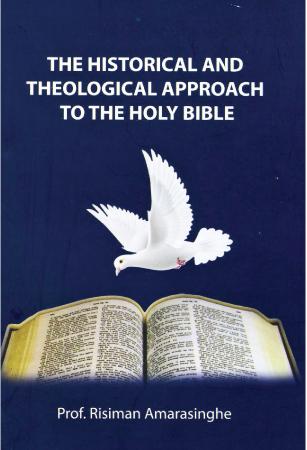
The Historical and Theological Approach to the Holy Bible
Publisher: S. Godage and Brothers (Pvt) Ltd
Price Rs. 350
Prof. RisimanAmarasinghe’s latest book “The Historical and Theological Approach to the Holy Bible” consists of four chapters dealing with the scientific revolution, the revolution in historical thinking, the theology of images and the fulfilment of the scriptures.
No religion can overlook the scientific revolution as we are living in the Age of Science. Copernicus, a Polish churchman, put forward the theory that the earth goes round the sun. It was a tentative hypothesis. After his death, scientists began to test such hypotheses. Up to the middle ages, however, questions of fact were settled not by experiment but by authority. The authority in spiritual matters was the Bible. Meanwhile, Christian theology came under attack by the new materialistic philosophy backed by Marxism and Aristotelian logic. St. Thomas Aquinas turned the new Aristotelian logic to defend the Christian view. According to the author, Aquinas succeeded in Christianizing Aristotle.
The Bible continued to exercise authority over the minds of the people long after Aristotle. Galileo challenged Aristotelian view. Isaac Newton demonstrated that all the movements of bodies in space could be described by a single law. It was the vindication of the theological argument for the existence of God. The ‘Principia Mathematica’ was a kind of scientific commentary upon Psalm 19: “The heavens declare the glory of God, and the firmament sheweth his handiwork.” As a result, Christian theologists of the 18th century did not find it necessary to defend Christianity against science. In fact, the 17th century scientists saw the hand of the Creator in the works of nature.
Scientific revolution
The second stage of the scientific revolution took place in the 19th century. An anonymous work titled ‘The Vestiges of Creation’ appeared in 1844 which put forward the evolutionary theory of human origins. However, its author was Robert Chambers (1802- 1871), who was a devout theist. He believed that the Theory of Evolution supported the Argument from Design. The author says, what Darwin and Wallace actually did was to provide the empirical evidence which the theory had hitherto lacked. He further says, “Darwin’s ‘Origin of Species’, as thoughtful Christians like R.W. Church recognized at the time was no more inimical to the revelation in Christ than Newton’s ‘Principia Mathematica’ had been.”
I found the chapter titled, ‘The theory of images’ quite fascinating. The story of Jesus and his resurrection presents us with the challenge of real history. Christ’s birth, suffering, death, resurrection and ascension are asserted, not as myths, but quite seriously as part of world history.
According to the author, Gospel writers were not biographers or historians. They recorded such things about the life and teachings of Jesus as aspects of their faith in him. It was Jesus, not the early church, who suggested the interpretation of his life and work which is found in the New Testament. He agrees that the language of religion is the language of the imagination, the language of poetry. Accordingly, there are metaphors, analogies, symbols and parables in the Bible. The author says, they are not literally true, but they are true analogically and poetically.
Popular question
The author has answered the popular question whether God is another name for nature. He says, “If God is only a generic name for the personified forces of nature, we have no need of that hypothesis. The God of the Bible is not mythological and the actions of God in history are not myths.
Coming to the last chapter titled, ‘The fulfilment of the scriptures,’ the reader is told in no uncertain terms that the Bible does not give him a divinely revealed chronology any more than it gives him a divinely revealed cosmology. We have to look to the sciences for information about the structure of the age of the material universe because such truths are not given in the Bible.
After reading the book, I can remember the author’s words vividly, “Christian people treasure the Bible as the testimony of those who were there when God revealed his presence and his saving power in the actual course of real history. This is the permanent value of the Bible.” The author’s words urge anyone to read the Bible with a new vision and understanding.
